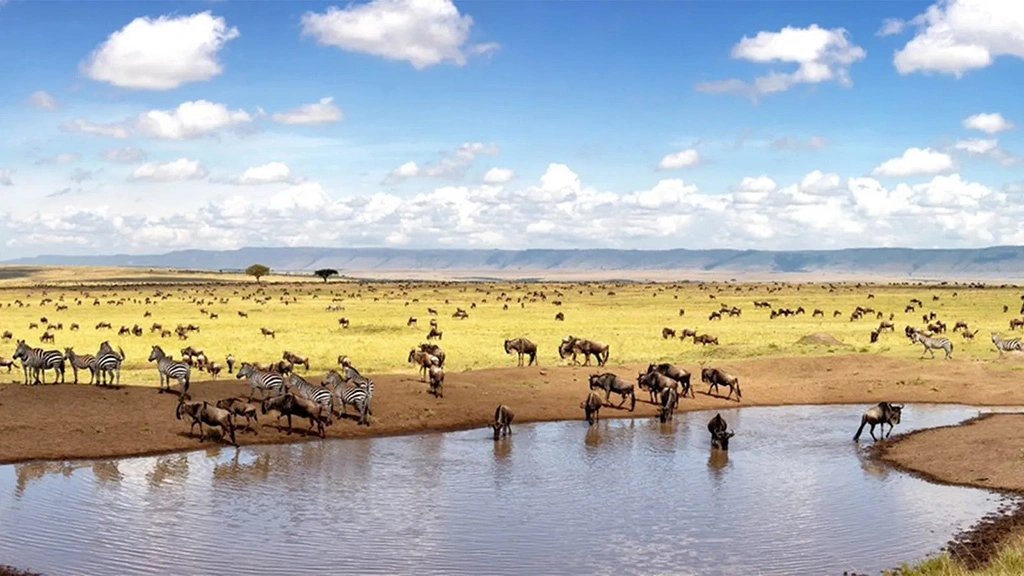Kenya vs Tanzania Safari: The Better African Safari Experience
Kenya and Tanzania are East Africa’s premier safari destinations, each offering breathtaking landscapes, diverse wildlife, and unique cultural experiences. Deciding between the two can be challenging, as both countries provide world-class safari adventures. To help you choose, here’s a detailed comparison of the safari experience in Kenya and Tanzania based on wildlife, landscapes, cultural experiences, accommodations, and accessibility.
1. Wildlife
Both Kenya and Tanzania are teeming with wildlife, but there are some distinctions.
- Kenya:
Kenya’s Masai Mara National Reserve is world-famous for the Great Migration, where millions of wildebeests, zebras, and gazelles cross the Mara River between July and October. The reserve is also known for its thriving populations of big cats like lions, leopards, and cheetahs. Other notable parks include Amboseli National Park, where elephants roam against the backdrop of Mount Kilimanjaro, and Samburu National Reserve, home to rare species like the Grevy’s zebra and reticulated giraffe. - Tanzania:
Tanzania boasts some of Africa’s most iconic parks, including the Serengeti National Park, which shares the Great Migration with the Masai Mara. The Ngorongoro Crater, a UNESCO World Heritage Site, offers unparalleled opportunities to see the “Big Five” (lion, leopard, elephant, buffalo, and rhino) in a compact area. Tarangire National Park is famous for its large elephant herds and towering baobab trees, while Selous Game Reserve provides a more off-the-beaten-path experience.
Verdict: If you’re focused on the Great Migration, Kenya’s Masai Mara offers a more concentrated and dramatic experience due to its smaller size. However, Tanzania’s Serengeti provides a more expansive migration spectacle with fewer crowds.
2. Landscapes
- Kenya:
Kenya’s landscapes are varied, ranging from the vast savannas of the Masai Mara to the dramatic escarpments of the Great Rift Valley. The country also offers unique ecosystems such as the swamps of Amboseli, the arid regions of Samburu, and the tropical coastlines of Mombasa and Lamu. - Tanzania:
Tanzania’s landscapes are equally diverse, dominated by the Serengeti’s endless plains and the breathtaking Ngorongoro Crater. The country also boasts Mount Kilimanjaro, Africa’s highest peak, and Lake Manyara, famous for its flamingos and tree-climbing lions. In southern Tanzania, you’ll find the remote wilderness of Selous and Ruaha National Parks.
Verdict: Tanzania’s landscapes are more diverse and dramatic, especially with the inclusion of Mount Kilimanjaro and the Ngorongoro Crater.
3. Cultural Experiences
- Kenya:
Kenya is home to the Maasai people, who have become synonymous with East Africa’s safari experience. Visitors can engage with Maasai communities, learning about their traditions, dances, and way of life. Other notable tribes include the Samburu and Turkana, each with their distinct culture. - Tanzania:
Tanzania also offers cultural encounters with the Maasai, as well as the Hadza people, one of the last hunter-gatherer tribes in Africa, and the Datoga, skilled blacksmiths. Cultural tours near parks like Lake Eyasi provide deeper insights into Tanzania’s indigenous heritage.
Verdict: Both countries offer rich cultural experiences, but Tanzania provides a wider variety of tribal interactions.
4. Accommodations and Luxury Options
- Kenya:
Kenya is renowned for its high-end luxury safari lodges and camps, particularly in private conservancies bordering the Masai Mara. These conservancies allow for exclusive activities like night drives and bush walks. Properties like Angama Mara and Ol Donyo Lodge set the standard for luxury safaris. - Tanzania:
Tanzania also offers exceptional accommodations, especially in the Serengeti and Ngorongoro areas. Luxury options such as Singita Grumeti and Ngorongoro Crater Lodge are world-class. Additionally, Tanzania’s mobile tented camps provide a unique way to follow the Great Migration.
Verdict: Both countries offer luxury safari options, but Kenya’s private conservancies provide a more exclusive and intimate experience.
5. Accessibility and Travel Logistics
- Kenya:
Kenya is generally more accessible, with Jomo Kenyatta International Airport in Nairobi serving as a major hub for international flights. The country’s smaller size allows for shorter travel times between parks. - Tanzania:
Tanzania’s Kilimanjaro International Airport in Arusha is the gateway to the northern safari circuit. However, due to the vastness of the country, travel between parks often involves long drives or domestic flights.
Verdict: Kenya wins for ease of travel, especially for those on a tight schedule.
6. Cost and Crowds
- Kenya:
Kenya’s Masai Mara can be crowded during peak migration season. However, private conservancies offer a more exclusive experience at a premium price. - Tanzania:
Tanzania’s Serengeti is larger, which helps disperse crowds, even during the migration. Overall, safaris in Tanzania can be slightly more expensive due to higher park fees and longer distances.
Verdict: For those seeking fewer crowds, Tanzania’s vastness is an advantage. Kenya offers better options for budget travelers.






